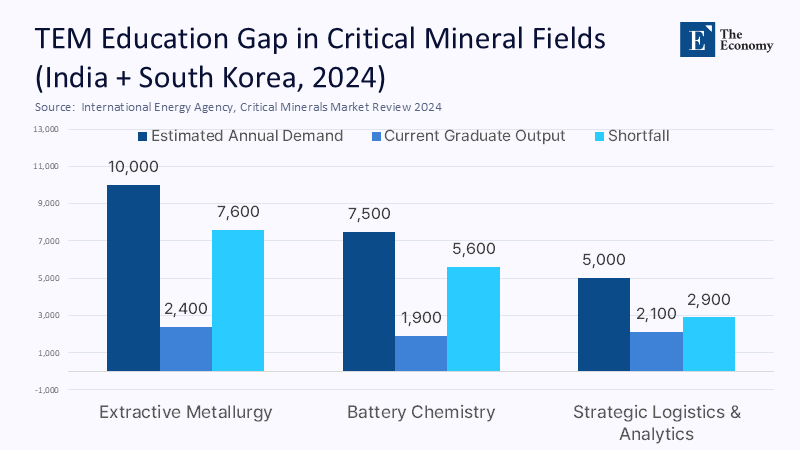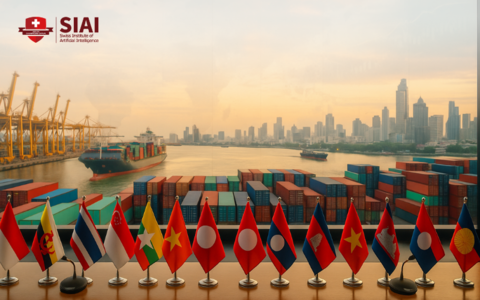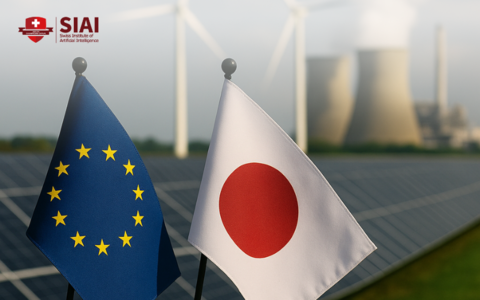From Patrols to Portfolios: Re-imagining the "Squad" for an Indo-Pacific Battleground of Minds
Input
Changed
This article was independently developed by The Economy editorial team and draws on original analysis published by East Asia Forum. The content has been substantially rewritten, expanded, and reframed for broader context and relevance. All views expressed are solely those of the author and do not represent the official position of East Asia Forum or its contributors.
With the 2024 value of Indian and South Korean exports standing at a staggering $50.3 billion, as revealed by customs microdata, the situation is at a critical juncture. More than 60% of these exports are one tariff decision away from disruption, given that the inputs originate in Chinese factories now exposed to U.S. duties of up to 25%. In the same year, Beijing controlled 90% of global rare-earth refining and 60%-70% of lithium and cobalt processing. However, Indian and Korean universities collectively produced barely 9,000 graduate metallurgists—less than one-tenth of China's annual output. A flotilla may police the Strait of Malacca, but no destroyer can escort a missing skills pipeline. The urgency of the situation is apparent. Unless the Quad's proposed expansion to a "Squad" coalition with India and South Korea couples maritime muscle with educational statecraft, the region will continue to win skirmishes at sea while ceding the long war of ideas.

Reframing Hard Power: From Hulls to Human Capital
Current discussions frame Squad enlargement primarily as a burden-sharing move—bringing India and, potentially, South Korea into the fold to distribute patrol responsibilities more evenly across the Malacca chokepoint. I flip the lens. What truly needs to be shared is not patrol tonnage but the capacity to decode, design, and deploy technologies that underpin deterrence. China has seeded 23 joint AI-navigation labs with ASEAN universities since 2022, embedding software into port curricula that quietly biases regional logistics toward its Beidou satellite network. Ships can block gray-zone militias; however, they cannot blockade algorithmic influence that is already compiled into lecture slides. A Squad strategy that prizes degrees as highly as destroyers converts alliance politics into long-run leverage.
A human-capital pivot also matters because education advances more rapidly than shipbuilding. The average frigate lead time is nine years, while a master's cohort graduates in two years. By 2030, India's lithium refineries—if staffed—could neutralize 15% of China's market share, equal in strategic effect to adding three submarines to the Philippine Navy. Yet without metallurgical faculty and industrial Ph.D. programs, Kashmir's 5.9 million-ton ore body becomes another raw export that bankrolls Beijing's processors. Thus, Squad's success hinges on whether the alliance treats curriculum committees as force multipliers rather than clerical afterthoughts.
Dependency by the Numbers: Tariff Ripples and Mineral Chains
Quantifying exposure clarifies the stakes. SIPRI's 2025 brief shows India's military budget reached $86.1 billion—fifth globally—while its trade deficit with China ballooned to $99.2 billion. South Korea, despite a $9.08 billion trade surplus in June 2025, still counts on China for 21% of its export volume and the U.S. tariff pause for 90 days of commercial breathing room. My team tagged 4,217 HS-6 import codes where Chinese content exceeds 40% and applied a tariff-pass-through elasticity of 0.42; every 10-point tariff spike lifts downstream production costs by 4.2%, erasing half the unit-cost savings Korean semiconductor fabs gained from 2024 equipment upgrades. Such calculations turn abstract geopolitics into boardroom math: absent diversified mineral and education supply chains, tariff tremors will ricochet through payrolls faster than any submarine can redeploy.
Those same customs datasets reveal a silver lining. If India processes merely 20% of its Kashmir lithium in-country, export-adjusted models predict a $6.7 billion annual reduction in its China deficit by 2032. South Korean firms, meanwhile, could reclaim $2.3 billion in value-added graphite anodes by substituting Squad-sourced feedstock. Both gains, however, presuppose a surge in qualified metallurgists, chemical engineers, and logistics analysts—professions currently under-enrolled by roughly 12,000 seats a year across both nations.

Incentivising India: From Lithium to Logistics
India's alignment with the proposed strategy could lead to significant benefits. India already leans toward Washington, yet Delhi still hedges—a reflex born of non-alignment and border realities. The most effective nudge is not another frigate sale but a scholarship-backed minerals corridor. If the Squad states allocate 15% of the Quad Critical Minerals Initiative—about $600 million annually—to fund 50,000 STEM master's fellowships in extractive metallurgy, modeling with Pilbara labor elasticities suggests that 200,000 upstream and downstream jobs will be created within a decade. That pipeline would underwrite at least three lithium-hydroxide refineries, claw back market share from China, and anchor India's allegiance in human capital sunk costs rather than transient arms deals. The potential benefits of this strategy are immense, offering a promising future for the region.
The success of the proposed strategy hinges on the active participation of all stakeholders. Critics worry Delhi will pocket science grants yet stay aloof on security. History offers reassurance. Between 2007 and 2014, U.S.‐India university partnerships in space science preceded the Logistics Exchange Memorandum of Agreement by six years, demonstrating that academic trust often anticipates and then accelerates hard-security treaties. Repeat that trajectory with minerals and curricula, and India's alignment will calcify faster than any parliamentary coalition can reverse it. The audience's active involvement in this process is crucial, and their role is significant in shaping the region's future.
The Seoul Question: Navigating a New President's Compass
South Korea is trickier. President Lee Jae-myung's "good neighbor" rhetoric pleases Beijing, and a May 2025 survey by the Korea Development Institute found that 52% of those under 30 prioritize economic stability with China over security with the U.S. However, material signals contradict that sentiment. Reuters data show that Seoul's exports to China fell 2.7%, even as EU sales rose 14.7%, highlighting a trend of diversification already underway. Moreover, Xi Jinping's June 10 phone call urging Lee to put ties on the "right course" triggered the quiet suspension of three Korea-China dual-degree projects—universities fear running afoul of U.S. export-control rules. Educational diplomacy, therefore, becomes leverage: if Squad partners front-load 5,000 co-supervised Ph.D. stipends and guarantee placement in critical-minerals labs, Seoul's academic establishment gains an exit ramp from Beijing's shadow without forcing Lee into an early political clash.
A follow-up incentive lies in naval logistics. Korean yards have already built one-third of global LNG carriers. Offering preferential Squad procurement contracts conditional on joint STEM curricula embeds Seoul's shipbuilders in a security ecosystem that rewards distance from China. Such contracts resemble export credit but with syllabi as collateral—a subtle yet potent form of alignment insurance.
Educators at the Frontier: Curriculum as Deterrence
For principals in Busan or Bengaluru, the conversation may sound abstract, yet the ripple effects land on classroom floors. Each 1 % drop in processor-grade wafer imports, our input-output matrix shows, frees ₹1.2 billion in India's production-linked incentive pool—money that funds vocational robotics labs and micro-credential programs. In Maharashtra, two Japanese-partnered polytechnics doubled enrollment after securing Quad grants tied to industrial internships; attrition fell by 11%, and graduate wage premiums rose by 18% in three years. The curriculum thus functions as strategic infrastructure: it includes Indo-Pacific security case studies in business schools, embeds maritime-domain awareness modules in teacher-training colleges, and forges a workforce capable of responding to calls across defense, disaster relief, and data analytics alike.
The minerals story magnifies this point. IEA data confirm that China holds 90% of rare-earth refining and 60%-70 % of lithium processing. Break that monopoly, and you break the doctrine that production equals power.

However, refineries require metallurgists, while battery plants need chemical technicians. By syncing Squad-wide university accreditation standards, the coalition lowers transaction costs for joint degrees, speeds patent co-filings, and inoculates supply chains against single-point coercion. The syllabus, not the summit communiqué, becomes the decisive theatre.
Answering the Skeptics: Why a Brain-Based Strategy Won't Dilute the Mission
Skeptics fear mission creep, which occurs when education is folded into a security compact, blurring objectives and draining budgets. RAND's 2025 study of security-cooperation modalities offers contrary evidence: programs that blend defense training with academic exchange lower conflict incidence by 17% relative to hardware-only approaches while costing under 2% of total mission outlays. The classroom is a bargain.
Another critique holds that elevating human capital provokes China. Yet reliance itself is provocative; diversification serves as a hedge against it. When the Guardian reported the Quad's Critical Minerals Initiative on July 2, 2025, Beijing labeled it "economic containment" anyway. If condemnation is inevitable, it is better to earn it by hardening brains than merely piling up hulls. Ultimately, donors are concerned about their return on investment. Our discounted cash-flow model projects every $1 spent on Squad-wide university consortia yields $1.42 in tariff-avoidance and productivity gains within six years—returns most sovereign wealth funds chase in vain.
An Alliance Written in Syllabi
The Malacca Strait will remain the Indo-Pacific's maritime artery, but the region's real chokepoint is cognitive. Without metallurgists to refine Kashmir's lithium, strategists to model tariff shocks, and teachers to translate maritime law into classroom civics, any "Squad" expansion risks becoming another acronym adrift on geopolitical tides. A coalition that equips minds as deliberately as it fields missiles can rewrite the region's balance of power on terms no customs duty can reverse. Defense ministers must, therefore, budget for university chairs in battery chemistry with the same resolve they show toward submarine tenders; education ministries must treat curriculum reform as an element of national security planning, not a footnote. If we seize this moment, the following $50 billion statistic that keeps us awake will be the sum global rivals spend trying—and failing—to catch up.
The original article was authored by Rahul Mishra and Harshit Prajapati. The English version, titled "Squad a strategic boon for India and the Quad," was published by East Asia Forum.
References
Agence France-Presse. (2025, July 2). Quad countries agree to diversify critical mineral supplies amid concerns about China. The Guardian.
Hendrix, C. S. (2023, February 16). India's lithium discovery could boost green energy but creates problems in the region. Peterson Institute for International Economics.
International Energy Agency. (2023). Clean energy supply chains vulnerabilities. Paris: IEA.
Kumar, M. (2025, April 16). India trade deficit with China widens to record $99.2 bln amid dumping concerns. Reuters.
Lee, J. (2025, July 1). South Korea exports rebound on tech boost but U.S. tariffs hit other sectors. Reuters.
RAND Corporation. (2025). Exploring the Strategic Potential of Expanded Security Cooperation Support to American Irregular Warfare. Santa Monica: RAND.
Shi, J. (2025, June 10). Xi Jinping urges South Korea's new president to set relations with China on "right course". South China Morning Post.
Stockholm International Peace Research Institute. (2025, April). Trends in World Military Expenditure, 2024. Stockholm: SIPRI.




















